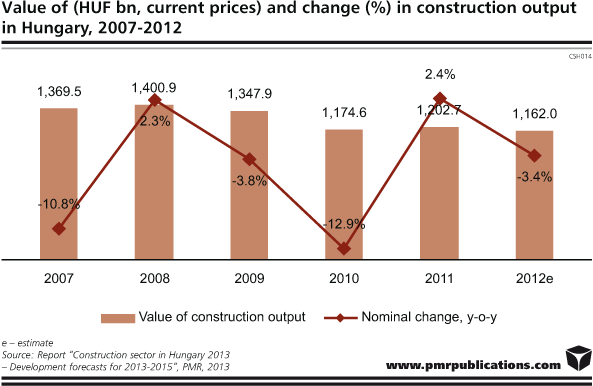Activity in Hungary’s civil engineering sector should gather momentum in the second half of 2013, on the back of road, railway, and tram construction and renovation plans as well as some previously announced sewerage treatment. Under favourable circumstances, total construction output could see an increase of as much as 5%.
PMR’s latest report “Construction sector in Hungary 2013 – Development forecasts for 2013-2015” suggests that, after a slight drop in 2012, the value of construction output in Hungary will expand by 5% in 2013, driven mostly by improvements in the civil engineering segment.
The increase in engineering output is likely to be led by transport infrastructure (mainly road) construction, provided that the absorption of EU funds is speeded up as the authorities have promised. Water supply projects should also be more active, since meeting EU requirements is becoming more urgent. In addition, stadium construction in Debrecen and Budapest will offer an opportunity thought lost.

Consequently, PMR analysts expect 2013 to deliver a 10% increase in civil engineering output that may go on to slow down slightly in 2014 as a result of the EU 2007-2014 budget coming to an end. However, from 2015, and thanks to a new EU financial programme, the sector will be revived, supported by construction work on new investment projects.
In fact, if the Hungarian economy in general does display some positive signs, some airport infrastructure or in heavy industry projects previously put on hold could be reactivated.
In non-residential construction only a few large projects are in the pipeline, thus any significant improvement would make an impact in 2014-2015 at the earliest. Moreover, there is plenty of existing vacant office and retail space that has to be let first. Development prospects for non-residential construction are likely to be influenced by two main issues. Firstly, the European debt crisis and its changes and its effects on a struggling Hungarian economy highly sensitive to any kind of external impact. Secondly, the sentiment of the market to the Hungarian government’s policies. Large institutional investors are still concerned about future political decisions and persistent distrust could make them abandon even their small-scale investment plans.
On the basis of the change in the number of building permits, a slight climb is likely for non-residential construction output in 2013. The prevailing lack of consumer demand and investor confidence is likely to delay any breakthrough in 2014, although a few large-scale projects should start if and when the government successfully deals with its budgetary issues. 2015 is the year when resources from the next EU financial framework are expected to make a noticeable contribution to industry performance, therefore relatively sizeable growth might be observed.
In residential construction a turning point is not likely to come in 2013, as it would require improvements in customer trust, growth in the willingness to go into debt, as well as better financing opportunities for developers. The number of building permits issued for dwellings in 2012 indicates that any notable recovery in the residential property market in the coming months is quite unlikely. The figure sank a further 15% year on year to 10,600, less than a quarter of the 2008 level. Budapest was the worst performer with an annual decline of 32%.
The construction of new homes has been declining for years, reaching a shockingly low level in 2012. It would also seem that the bottom has not yet been reached. Well-known developers, both Hungarian and foreign, have actually left the Hungarian market because of the lack of demand. Only a few large scale developments are in progress or planned, and almost all of those are in the capital. Most investors with projects not yet sold are focusing only on sales, which is why supply is rapidly running out.
However, with the government working on a new housing subsidy system, there is hope that residential construction is poised to experience some degree of recovery after 2013.
Source: PMR
Tags News
 Constructionshows
Constructionshows